|
|
|
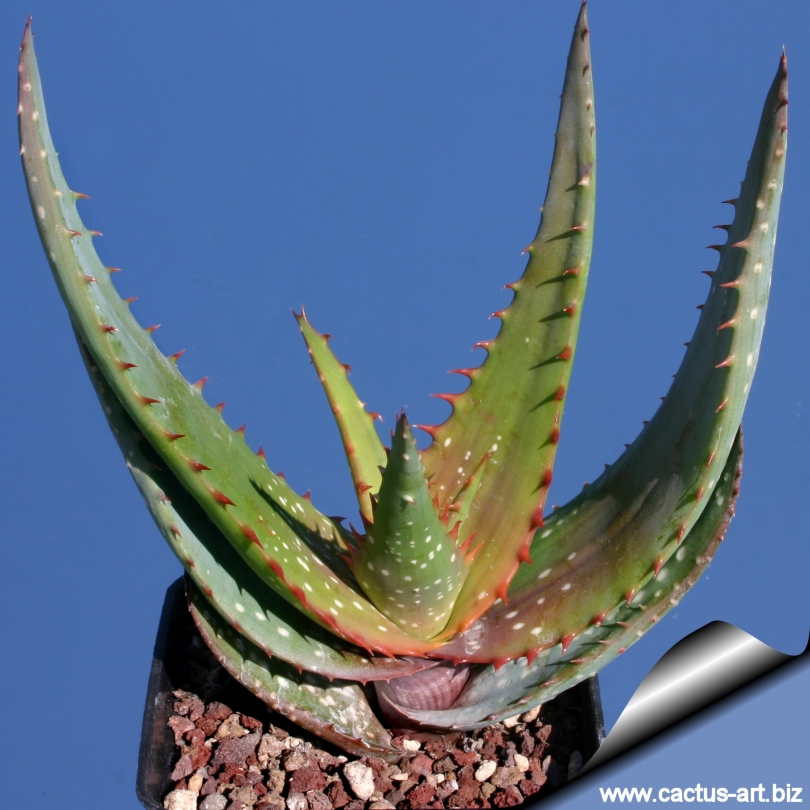
Aloe microstigma (A
young specimen)
Leaves have subtle white flecking. In winter, they can become
incredibly colourful showing pinks, purples, yellows and greens. Each
season has a distinct attractiveness it is a very beautiful aloe!
|
|
Description: Aloe microstigma is a medium
size and very attractive aloe that usually occur singularly or in small
groups, up to 50 cm in diameter and 60-70 cm tall.
Stem: Young plants are stemless, while the older ones develop a
short decumbent stem up to 50 cm tall and 10 cm wide, which is usually
covered with remains of old leaves .
Leaves: Up to 40 cm long and 7.5 cm wide, lanceolated to deltoid
arranged in spiralled rosettes (, but in juvenile plants they are ranked
in vertical rows). Conspicuously scattered with white spots on the upper
and lower surface, which contrast well with the reddish-brown teeth
along the margins. Teeth non pungent 2-4 mm long, 5-10 mm apart. The
leaves start out horizontal along the ground and suddenly turn up to the
sky so that the tip is vertical. Mature leaves are a solid brownish
green, the young growing leaves are tender light green and have many
fine white dots, but in full sun, may get yellowy and sunburned. In
shade has a more turquoise colouration. In winter, leaves can become
incredibly colourful showing pinks, purples, yellows and greens and in
general turn reddish brown if suffering from environmental stress.
Flowers: This species shows a variety of flower colours ranging
from yellow to red with all the colour possibilities in between. They
typically are red until they are open, and then turn pure yellow. In
some plant, however, the buds and open flowers may be uniformly red or
yellow. The robust simple raceme (stem on which all flowers are borne)
are conical to cylindrical-accumulative 90-100 cm long, coming out
(usually) 1-3 at a time.
Blooming season: Flowers profusely from late autumn until
January.
Seeds: Small, black to 2 mm in diameter, inconspicuously winged
and wind dispersed.
|
|
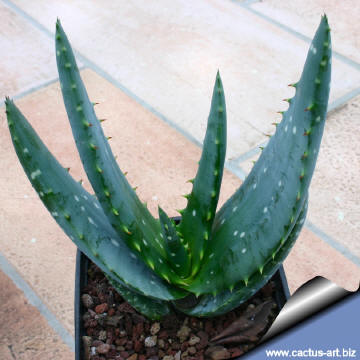 |
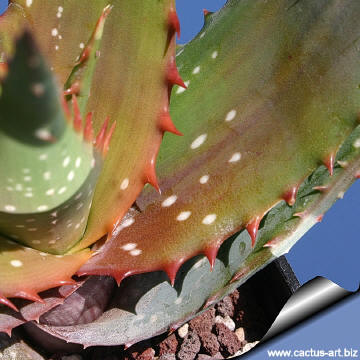 |
|
A. microstigma means 'very
small spot' and conspicuous white spots appear on the leaves, which
contrast well with the reddish teeth along the margins. |
|
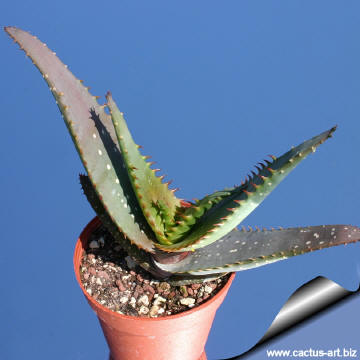 |
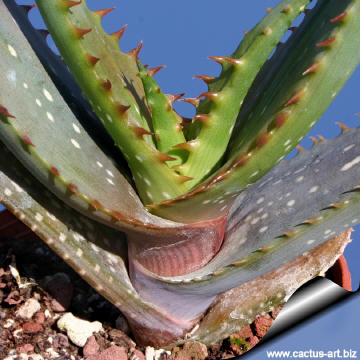 |
|
Aloe microstigma is one of the most floriferous aloes in South Africa
with a wonderfull towering inflorescence that resembles flaming torches. |
|
Advertising
|
|
|
|
|
Family: Asphodelaceae Subfamily:
Alooideae
Scientific name:
Aloe microstigma Salm-Dyck
In: Monograph. Gen. Aloes & Mesemb. Sect. 26:fig 4 (fasc.
6:fig11) 1854
Common Names include: Bottlebrush
Aloe, Rosary Vine
Origin: Southern Africa, where it is a common and widely
distributed plant in the interior of the Western and Eastern Cape(Little
Karoo, Noorsveld)
Habitat: it can
be found in a variety of dry habitats comprising flat open areas, steep
rocky slopes, or amongst bushes. Where they grow, they are near to
invisible between rocks and dry bushes.
Ecology: Aloe microstigma is pollinated primarily by sugar birds
particularly the lesser double collard sugar bird which extracts the
nectar produced by the flowers. Insects may also be responsible for
pollination. Seeds are produced in abundance and this serves as a
survival mechanism. Seeds are parasitized by small day flies that lay
their eggs in the seeds, their larvae then live off the seeds. The
success of germination is relatively high giving rise to the abundance
of the species. The rosette of leaves helps to cool the plant in that
the upper leaves provides shading for the lower ones. Another
interesting adaptation is the inward folding of leaves during the hot
summer months. This helps to protect the softer and younger leaves from
extreme temperatures. Leaves unfold again in cool weather.
Etymology: The species name microstigma derives
from Greek 'mikros', 'small'; and Greek 'stigma',
'spot, stigma'. Hence the scientific name accurately describes
the distinguishing very small spotted leaves of the plant
Synonyms:
- Aloe brunnthaleri A. Berger ex
Cammerloher 1933
- Aloe juttae dinter 1923
|
|
|
|
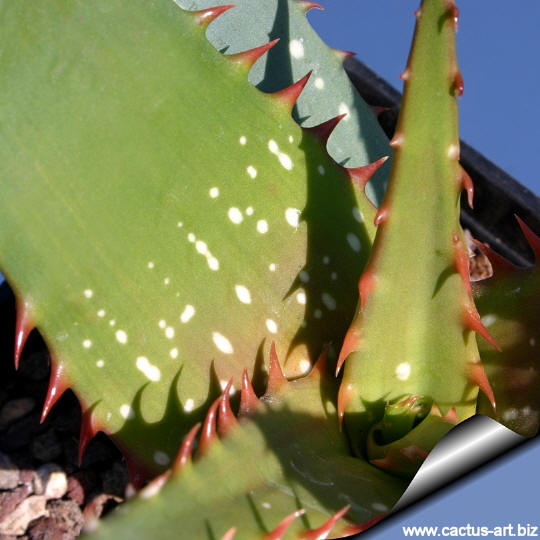
Cultivation: Easy to grow, requiring
very little care. It can be grown in large containers. Always use a good
quality, loamy sandy soil with plenty of drainage chips at the bottom of
containers. It tolerates weekly watering in the summer; once a month, or
not at all in the colder months of December and January. Can withstand
long periods of drought, but they will thrive and flower more profusely
if watered in the correct season. Incorrect watering, poor drainage or
too much shade can lead to attack by pests and diseases. They can take a
few degrees of frost in winter as well, but prefer hot summers. It grows
much better outdoors in spring and summer.
In mild climates it can be cultivated outdoors for use in landscaping,
preferably planting it in hot and dry rock gardens. They will grow best
in regions with a climate close to that of their native deserts
not too cold, and not too wet.
They grow slowly, but not agonisingly so being able to increase their
height by 10- 30 (or more) cm per year under favourable conditions.
Propagation: Almost
exclusively by seeds planted in autumn, in trays of coarse river sand.
Truncheons (if available) can also be used for propagation. Truncheons
must be dried out for at least 3 weeks before planting in river sand.
This is quite a difficult alternative and success is not always
guaranteed.
Uses:
- Gardening: This aloe can be grown in large, rocky, well-drained
soil in gardens in drier areas. It is very drought
resistant but susceptible to frost. They make particularly nice low
maintenance garden plants which are especially attractive when in
flower in the barren winter months.
- Medicine: Aloe microstigma is not
recorded as a medicinal plant but it is said that the bitter sap has
healing properties in cases of cuts and burn wounds.
|
|

 |
|